width BMW ACTIVE HYBRID 7 2013 F04 Owner's Manual
[x] Cancel search | Manufacturer: BMW, Model Year: 2013, Model line: ACTIVE HYBRID 7, Model: BMW ACTIVE HYBRID 7 2013 F04Pages: 253, PDF Size: 5.01 MB
Page 56 of 253
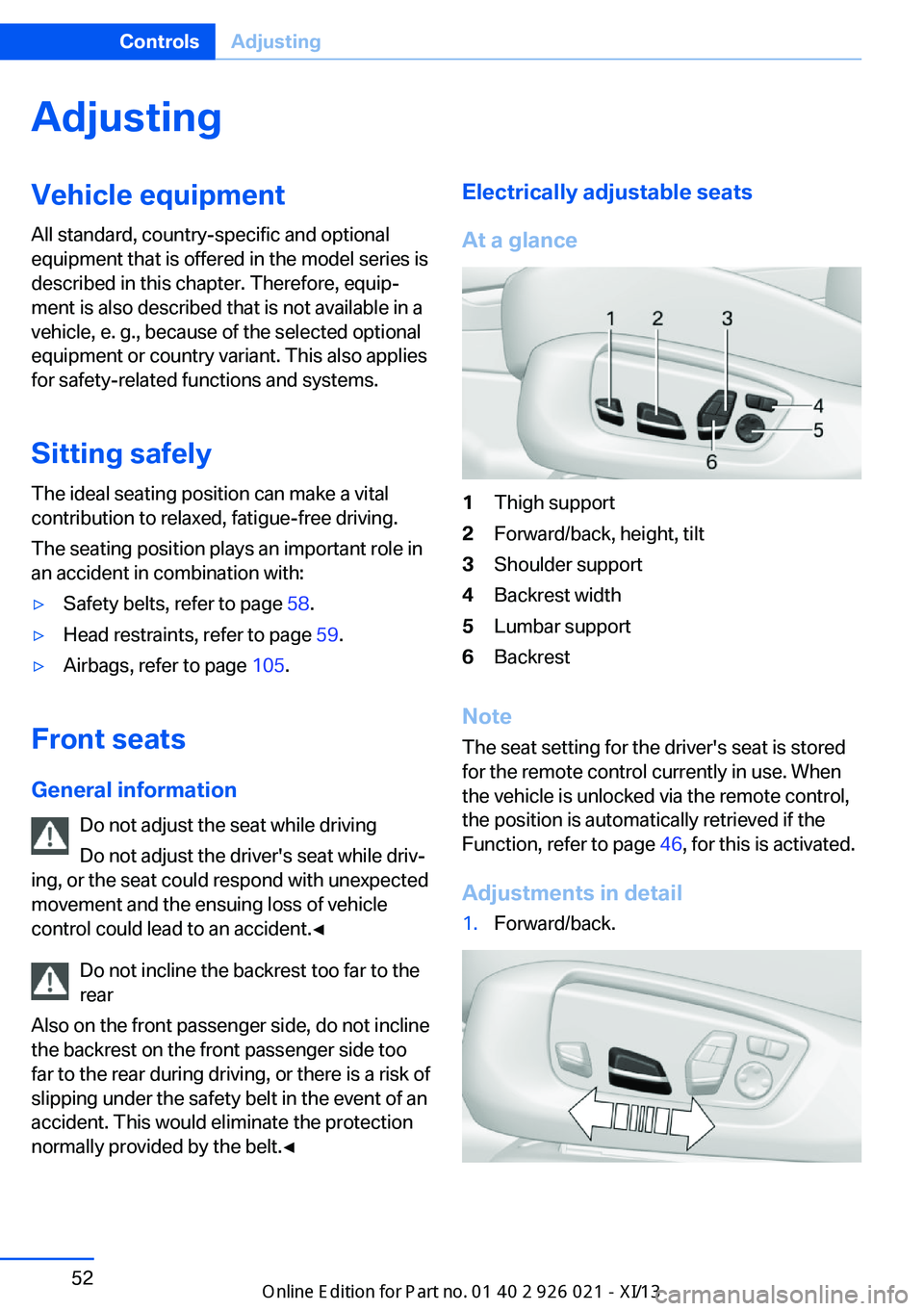
AdjustingVehicle equipment
All standard, country-specific and optional
equipment that is offered in the model series is
described in this chapter. Therefore, equip‐
ment is also described that is not available in a
vehicle, e. g., because of the selected optional
equipment or country variant. This also applies
for safety-related functions and systems.
Sitting safely The ideal seating position can make a vital
contribution to relaxed, fatigue-free driving.
The seating position plays an important role in
an accident in combination with:▷Safety belts, refer to page 58.▷Head restraints, refer to page 59.▷Airbags, refer to page 105.
Front seats
General information Do not adjust the seat while driving
Do not adjust the driver's seat while driv‐
ing, or the seat could respond with unexpected
movement and the ensuing loss of vehicle
control could lead to an accident.◀
Do not incline the backrest too far to the
rear
Also on the front passenger side, do not incline
the backrest on the front passenger side too far to the rear during driving, or there is a risk of
slipping under the safety belt in the event of an
accident. This would eliminate the protection
normally provided by the belt.◀
Electrically adjustable seats
At a glance1Thigh support2Forward/back, height, tilt3Shoulder support4Backrest width5Lumbar support6Backrest
Note The seat setting for the driver's seat is stored
for the remote control currently in use. When
the vehicle is unlocked via the remote control,
the position is automatically retrieved if the
Function, refer to page 46, for this is activated.
Adjustments in detail
1.Forward/back.Seite 52ControlsAdjusting52
Online Edition for Part no. 01 40 2 909 774 - VI/13
Page 57 of 253

2.Height.3.Seat tilt.4.Backrest tilt.5.Thigh support.Lumbar support
The curvature of the seat backrest can be ad‐
justed in such a way that it supports the lumbar
region of the spine. The lower back and the
spine are supported for upright posture.▷Press the front/rear section
of the switch.
The curvature is increased/
decreased.▷Press the upper/lower sec‐
tion of the switch.
The curvature is shifted up/
down.
Backrest width
Change the width of the back‐
rest using the side wings to ad‐
just the lateral support.
To make it easier to enter and exit the vehicle,
the backrest width temporarily opens fully.
Shoulder support
Also supports the back in the shoulder area:
▷Results in a relaxed seating position.▷Reduces strain on the shoulder muscles.
Gentleman function
The front passenger seat can be adjusted with
the switches of the driver's seat.
Seite 53AdjustingControls53
Online Edition for Part no. 01 40 2 909 774 - VI/13
Page 67 of 253
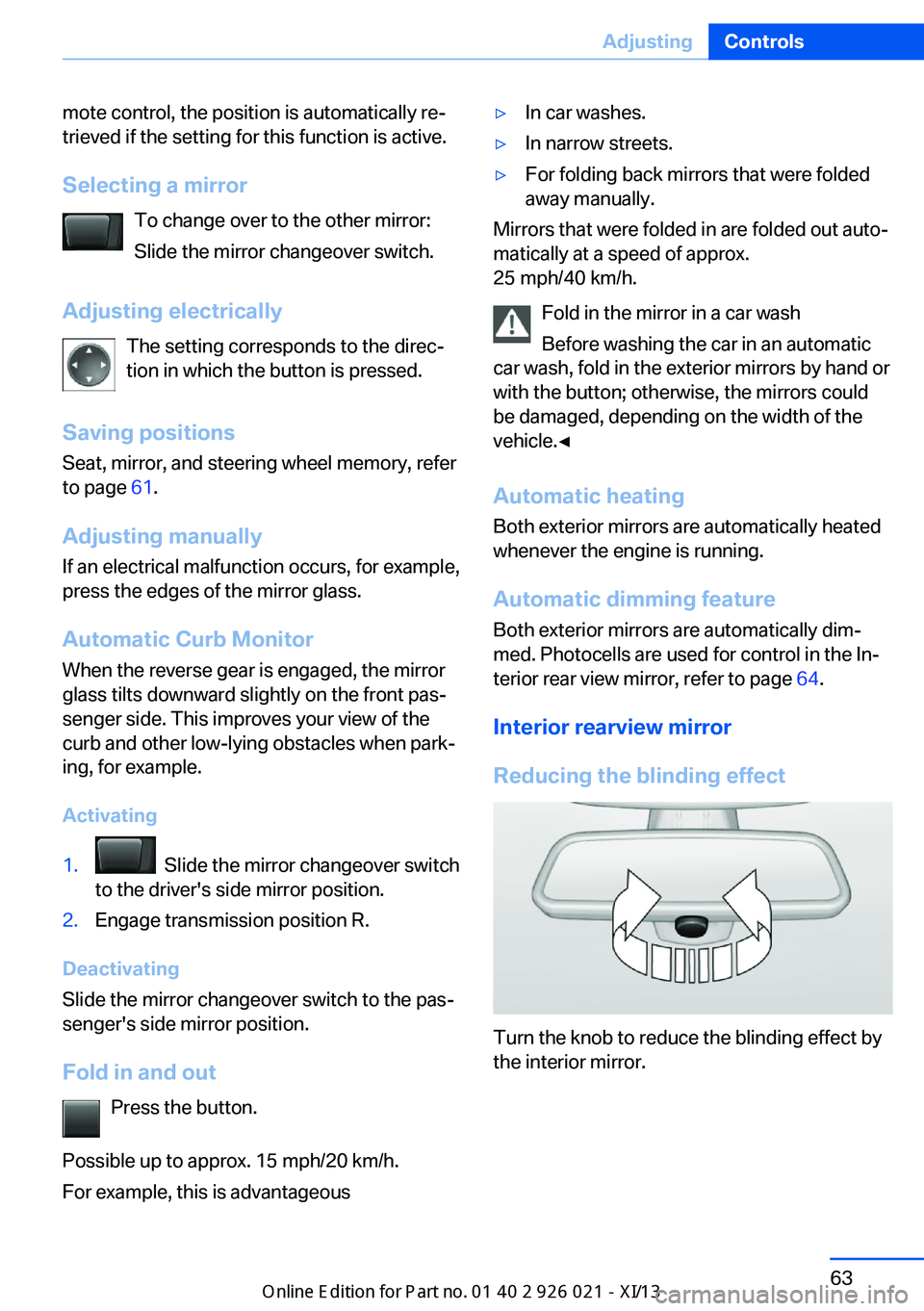
mote control, the position is automatically re‐
trieved if the setting for this function is active.
Selecting a mirror To change over to the other mirror:Slide the mirror changeover switch.
Adjusting electrically The setting corresponds to the direc‐
tion in which the button is pressed.
Saving positions Seat, mirror, and steering wheel memory, refer
to page 61.
Adjusting manually
If an electrical malfunction occurs, for example,
press the edges of the mirror glass.
Automatic Curb Monitor
When the reverse gear is engaged, the mirror
glass tilts downward slightly on the front pas‐
senger side. This improves your view of the
curb and other low-lying obstacles when park‐
ing, for example.
Activating1. Slide the mirror changeover switch
to the driver's side mirror position.2.Engage transmission position R.
Deactivating
Slide the mirror changeover switch to the pas‐
senger's side mirror position.
Fold in and out Press the button.
Possible up to approx. 15 mph/20 km/h.
For example, this is advantageous
▷In car washes.▷In narrow streets.▷For folding back mirrors that were folded
away manually.
Mirrors that were folded in are folded out auto‐
matically at a speed of approx.
25 mph/40 km/h.
Fold in the mirror in a car wash
Before washing the car in an automatic
car wash, fold in the exterior mirrors by hand or
with the button; otherwise, the mirrors could
be damaged, depending on the width of the
vehicle.◀
Automatic heating
Both exterior mirrors are automatically heated
whenever the engine is running.
Automatic dimming feature Both exterior mirrors are automatically dim‐
med. Photocells are used for control in the In‐
terior rear view mirror, refer to page 64.
Interior rearview mirror
Reducing the blinding effect
Turn the knob to reduce the blinding effect by
the interior mirror.
Seite 63AdjustingControls63
Online Edition for Part no. 01 40 2 909 774 - VI/13
Page 71 of 253

Lock the rear seat backrests in position
Before installing a child restraint system,
make sure that the rear seat backrests are
locked; otherwise, the protective effect is not
guaranteed and there is an increased risk of in‐
jury for the child in the event of an accident.◀
On the front passenger seat
Deactivating airbags
After installing a child restraint fixing system in
the front passenger seat, make sure that the
front, knee and side airbags on the front pas‐
senger side are deactivated.
Deactivate the front passenger airbags auto‐
matically, refer to page 107.
Deactivating the front passenger airbags
If a child restraint fixing system is used in
the front passenger seat, the front passenger
airbags must be deactivated; otherwise, there
is an increased risk of injury to the child when
the airbags are triggered, even with a child re‐
straint fixing system.◀
Seat position and height
Before installing a child restraint fixing system,
move the front passenger seat as far back as
possible and bring it up to medium height to
obtain the best possible position for the belt
and to offer optimal protection in the event of
an accident.
Do not change the seat position and height af‐
ter this.
Backrest width Adjustable backrest width: before installing a
child restraint fixing system in the front pas‐
senger seat, open the backrest width com‐
pletely. Do not change the backrest width
again and do not call up a memory position.Backrest width for the child seat
Before installing a child restraint fixing
system in the front passenger seat, the back‐
rest width must be opened completely. Do not
change the adjustment after this; otherwise,
the stability of the child seat will be reduced.◀
Child seat security
The rear safety belts and the front passenger
safety belt can be locked against pulling out for
mounting the child restraint fixing systems.
Locking the safety belt
1.Pull out the belt webbing completely.2.Secure the child restraint fixing system
with the belt.3.Allow the belt webbing to be pulled in and
pull it taut against the child restraint fixing
system. The safety belt is locked.
Unlocking the safety belt
1.Unbuckle the belt buckle.2.Remove the child restraint fixing system.3.Allow the belt webbing to be pulled in com‐
pletely.
LATCH child restraint fixing
system
LATCH: Lower Anchors and Tether for CHil‐dren.
Seite 67Transporting children safelyControls67
Online Edition for Part no. 01 40 2 909 774 - VI/13
Page 205 of 253
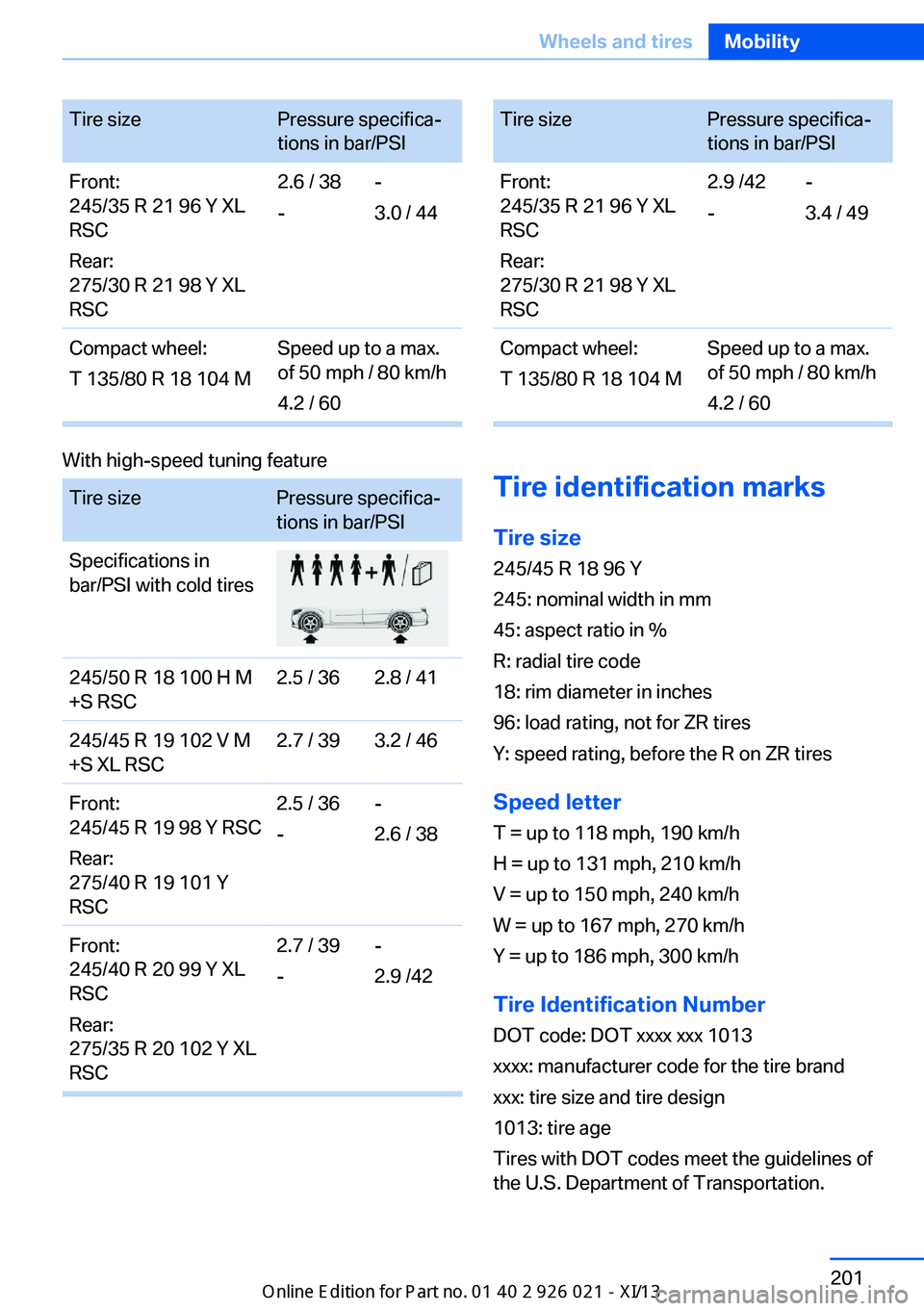
Tire sizePressure specifica‐
tions in bar/PSIFront:
245/35 R 21 96 Y XL
RSC
Rear:
275/30 R 21 98 Y XL
RSC2.6 / 38
--
3.0 / 44Compact wheel:
T 135/80 R 18 104 MSpeed up to a max.
of 50 mph / 80 km/h
4.2 / 60
With high-speed tuning feature
Tire sizePressure specifica‐
tions in bar/PSISpecifications in
bar/PSI with cold tires245/50 R 18 100 H M
+S RSC2.5 / 362.8 / 41245/45 R 19 102 V M
+S XL RSC2.7 / 393.2 / 46Front:
245/45 R 19 98 Y RSC
Rear:
275/40 R 19 101 Y
RSC2.5 / 36
--
2.6 / 38Front:
245/40 R 20 99 Y XL
RSC
Rear:
275/35 R 20 102 Y XL
RSC2.7 / 39
--
2.9 /42Tire sizePressure specifica‐
tions in bar/PSIFront:
245/35 R 21 96 Y XL
RSC
Rear:
275/30 R 21 98 Y XL
RSC2.9 /42
--
3.4 / 49Compact wheel:
T 135/80 R 18 104 MSpeed up to a max.
of 50 mph / 80 km/h
4.2 / 60
Tire identification marks
Tire size 245/45 R 18 96 Y
245: nominal width in mm
45: aspect ratio in %
R: radial tire code
18: rim diameter in inches
96: load rating, not for ZR tires
Y: speed rating, before the R on ZR tires
Speed letter
T = up to 118 mph, 190 km/h
H = up to 131 mph, 210 km/h
V = up to 150 mph, 240 km/h
W = up to 167 mph, 270 km/h
Y = up to 186 mph, 300 km/h
Tire Identification Number
DOT code: DOT xxxx xxx 1013
xxxx: manufacturer code for the tire brand
xxx: tire size and tire design
1013: tire age
Tires with DOT codes meet the guidelines of
the U.S. Department of Transportation.
Seite 201Wheels and tiresMobility201
Online Edition for Part no. 01 40 2 909 774 - VI/13
Page 206 of 253

Tire age
DOT … 1013: the tire was manufactured in the
10th week 2013.
Recommendation
Regardless of wear, replace tires at least every
6 years.
Uniform Tire Quality GradingQuality grades can be found where applicable
on the tire sidewall between tread shoulder
and maximum section width.
For example: Treadwear 200; Traction AA;
Temperature A
DOT Quality Grades
Treadwear
Traction AA A B C
Temperature A B C
All passenger car tires must conform to Fed‐
eral Safety Requirements in addition to these
grades.
TreadwearThe treadwear grade is a comparative rating
based on the wear rate of the tire when tested
under controlled conditions on a specified gov‐
ernment test course. For example, a tire graded 150 would wear one and one-half, 1 g,
times as well on the government course as a
tire graded 100. The relative performance of
tires depends upon the actual conditions of
their use, however, and may depart signifi‐
cantly from the norm due to variations in driv‐
ing habits, service practices and differences in
road characteristics and climate.
Traction
The traction grades, from highest to lowest, are AA, A, B, and C.
Those grades represent the tire's ability to
stop on wet pavement as measured under
controlled conditions on specified governmenttest surfaces of asphalt and concrete. A tire
marked C may have poor traction performance.
The traction grade assigned to this tire is
based on straight-ahead braking traction tests,
and does not include acceleration, cornering,
hydroplaning, or peak traction characteristics.
Temperature
The temperature grades are A, the highest, B,
and C, representing the tire's resistance to the
generation of heat and its ability to dissipate
heat when tested under controlled conditions
on a specified indoor laboratory test wheel.
Sustained high temperature can cause the ma‐
terial of the tire to degenerate and reduce tire
life, and excessive temperature can lead to
sudden tire failure. The grade C corresponds
to a level of performance which all passenger
car tires must meet under the Federal Motor
Vehicle Safety Standard No. 109. Grades Band
A represent higher levels of performance on
the laboratory test wheel than the minimum re‐
quired by law.
Temperature grade for this tire
The temperature grade for this tire is es‐
tablished for a tire that is properly inflated and
not overloaded. Excessive speed, underinfla‐
tion, or excessive loading, either separately or
in combination, can cause heat buildup and
possible tire failure.
If necessary, have the vehicle towed.◀
RSC – Run-flat tires
Run-flat tires, refer to page 205, are labeled
with a circular symbol containing the letters RSC marked on the sidewall.
M+S
Winter and all-season tires with better cold
weather performance than summer tires.Seite 202MobilityWheels and tires202
Online Edition for Part no. 01 40 2 909 774 - VI/13
Page 231 of 253

CareVehicle equipmentAll standard, country-specific and optional
equipment that is offered in the model series is
described in this chapter. Therefore, equip‐
ment is also described that is not available in a
vehicle, e. g., because of the selected optional
equipment or country variant. This also applies
for safety-related functions and systems.
Car washes Hints Steam jets or high-pressure washers
When using steam jets or high-pressure
washers, hold them a sufficient distance away and use a maximum temperature of
140 ℉/60 ℃.
If the vehicle has a glass sunroof, ensure that a distance of at least 31.5 inches/80 cm is main‐
tained. Holding them too close or using exces‐
sively high pressures or temperatures can
cause damage or preliminary damage that may
then lead to long-term damage.
Follow the user's manual for the high-pressure
washer.◀
Cleaning sensors/cameras with high-
pressure washers
When using high-pressure washers, do not
spray the exterior sensors and cameras, e.g., Park Distance Control, for extended periods of
time and only from a distance of at least
12 in/30 cm.◀
Regularly remove foreign items such as leaves
in the area below the windshield when the
hood is raised.
Wash your vehicle frequently, particularly in
winter.Intense soiling and road salt can damage the
vehicle.
Automatic car washes
Hints
Note the following:▷Give preference to cloth car washes or
those that use soft brushes in order to
avoid paint damage.▷Make sure that the wheels and tires are not
damaged by the transport mechanisms.▷Fold in the exterior mirrors; otherwise, they
may be damaged, depending on the width
of the vehicle.▷Deactivate the rain sensor, refer to
page 80, to avoid unintentional wiper acti‐
vation.▷In some cases, an unintentional alarm can
be triggered by the interior motion sensor
of the alarm system. Follow the instruc‐
tions on avoiding an unintentional alarm,
refer to page 47.
Guide rails in car washes
Avoid car washes with guide rails higher
than 4 in/10 cm; otherwise, the vehicle body
could be damaged.◀
Before driving into a car wash In order to ensure that the vehicle can roll in a
car wash, take the following steps:
1.Drive into the car wash.2.Engage transmission position N.3.Switch the engine off.
In this way, the ignition remains switched
on, and a Check-Control message is dis‐
played.Seite 227CareMobility227
Online Edition for Part no. 01 40 2 909 774 - VI/13
Page 238 of 253

Technical dataVehicle equipment
All standard, country-specific and optional
equipment that is offered in the model series is
described in this chapter. Therefore, equip‐ment is also described that is not available in a
vehicle, e. g., because of the selected optional
equipment or country variant. This also applies
for safety-related functions and systems.
Dimensions
Width, height with roof-mounted aerial
1Vehicle height:
Vehicle height: 58.1 inches/1,476 mm
L model: 58.5 inches / 1,487 mm2Vehicle width, without mirrors: 74.9 in‐
ches / 1,902 mm3Vehicle width, with mirrors: 84.3 in‐
ches / 2,142 mmSeite 234ReferenceTechnical data234
Online Edition for Part no. 01 40 2 909 774 - VI/13
Page 242 of 253
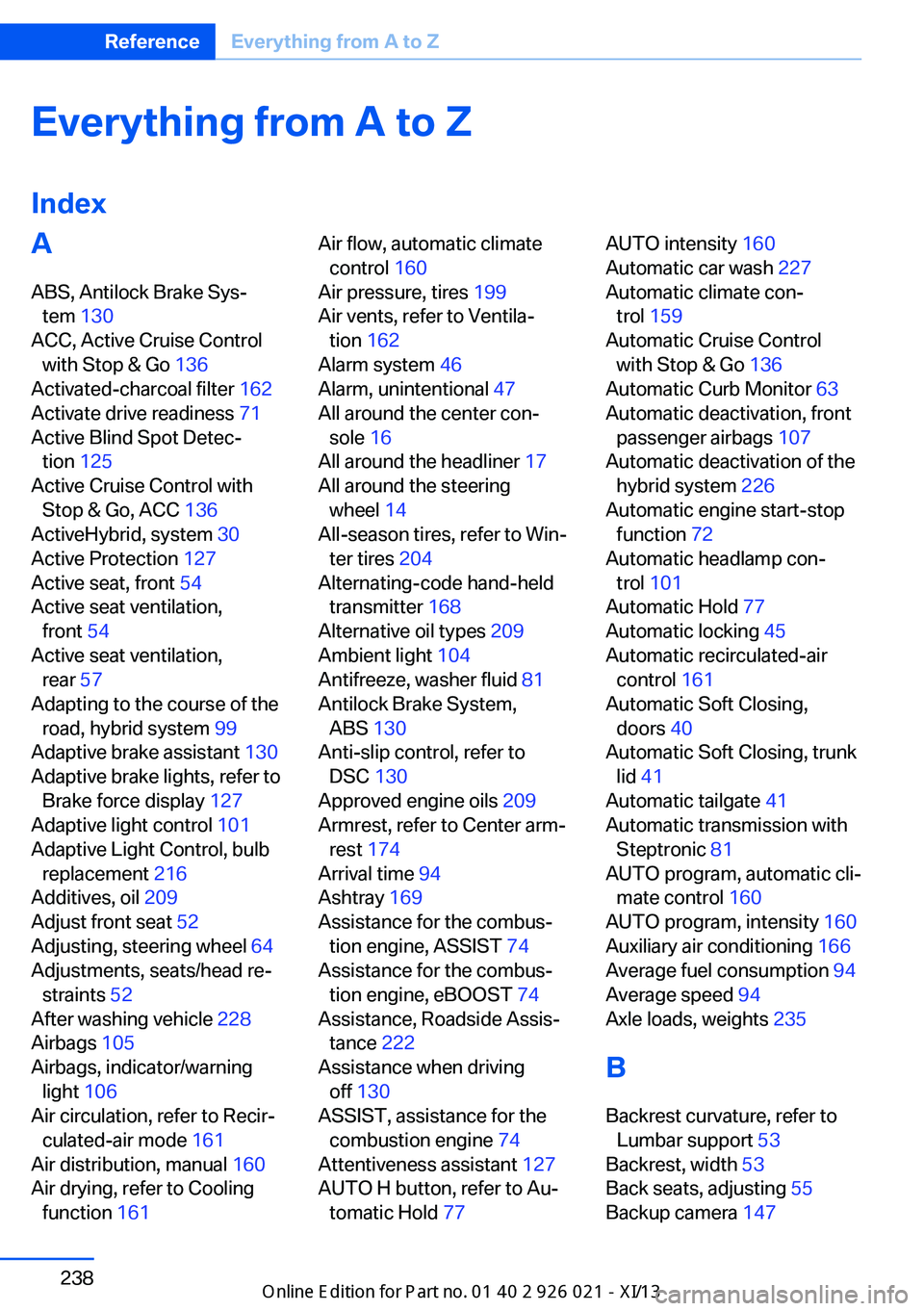
Everything from A to Z
IndexA ABS, Antilock Brake Sys‐ tem 130
ACC, Active Cruise Control with Stop & Go 136
Activated-charcoal filter 162
Activate drive readiness 71
Active Blind Spot Detec‐ tion 125
Active Cruise Control with Stop & Go, ACC 136
ActiveHybrid, system 30
Active Protection 127
Active seat, front 54
Active seat ventilation, front 54
Active seat ventilation, rear 57
Adapting to the course of the road, hybrid system 99
Adaptive brake assistant 130
Adaptive brake lights, refer to Brake force display 127
Adaptive light control 101
Adaptive Light Control, bulb replacement 216
Additives, oil 209
Adjust front seat 52
Adjusting, steering wheel 64
Adjustments, seats/head re‐ straints 52
After washing vehicle 228
Airbags 105
Airbags, indicator/warning light 106
Air circulation, refer to Recir‐ culated-air mode 161
Air distribution, manual 160
Air drying, refer to Cooling function 161 Air flow, automatic climate
control 160
Air pressure, tires 199
Air vents, refer to Ventila‐ tion 162
Alarm system 46
Alarm, unintentional 47
All around the center con‐ sole 16
All around the headliner 17
All around the steering wheel 14
All-season tires, refer to Win‐ ter tires 204
Alternating-code hand-held transmitter 168
Alternative oil types 209
Ambient light 104
Antifreeze, washer fluid 81
Antilock Brake System, ABS 130
Anti-slip control, refer to DSC 130
Approved engine oils 209
Armrest, refer to Center arm‐ rest 174
Arrival time 94
Ashtray 169
Assistance for the combus‐ tion engine, ASSIST 74
Assistance for the combus‐ tion engine, eBOOST 74
Assistance, Roadside Assis‐ tance 222
Assistance when driving off 130
ASSIST, assistance for the combustion engine 74
Attentiveness assistant 127
AUTO H button, refer to Au‐ tomatic Hold 77 AUTO intensity 160
Automatic car wash 227
Automatic climate con‐ trol 159
Automatic Cruise Control with Stop & Go 136
Automatic Curb Monitor 63
Automatic deactivation, front passenger airbags 107
Automatic deactivation of the hybrid system 226
Automatic engine start-stop function 72
Automatic headlamp con‐ trol 101
Automatic Hold 77
Automatic locking 45
Automatic recirculated-air control 161
Automatic Soft Closing, doors 40
Automatic Soft Closing, trunk lid 41
Automatic tailgate 41
Automatic transmission with Steptronic 81
AUTO program, automatic cli‐ mate control 160
AUTO program, intensity 160
Auxiliary air conditioning 166
Average fuel consumption 94
Average speed 94
Axle loads, weights 235
B Backrest curvature, refer to Lumbar support 53
Backrest, width 53
Back seats, adjusting 55
Backup camera 147 Seite 238ReferenceEverything from A to Z238
Online Edition for Part no. 01 40 2 909 774 - VI/13
Page 251 of 253
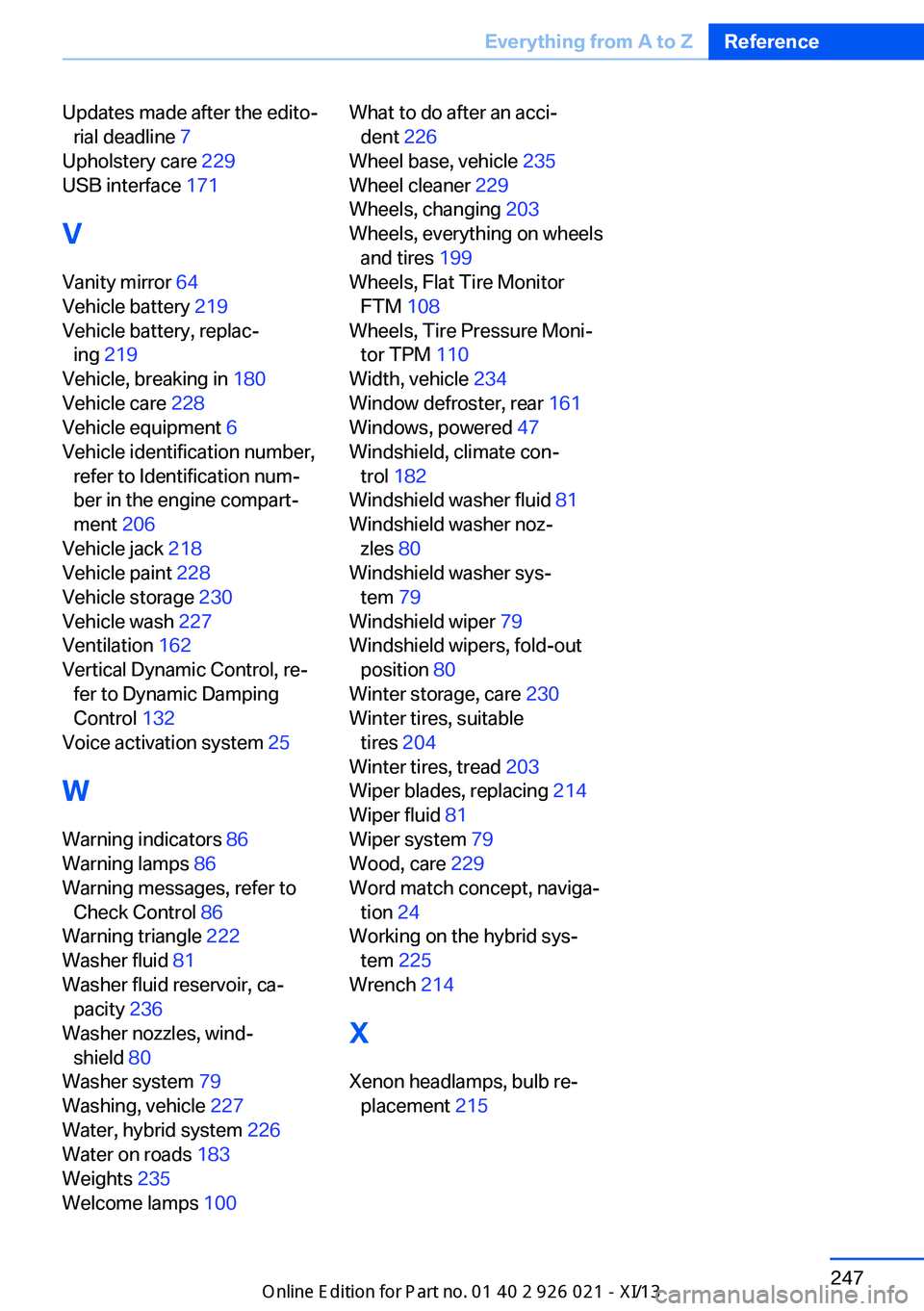
Updates made after the edito‐rial deadline 7
Upholstery care 229
USB interface 171
V
Vanity mirror 64
Vehicle battery 219
Vehicle battery, replac‐ ing 219
Vehicle, breaking in 180
Vehicle care 228
Vehicle equipment 6
Vehicle identification number, refer to Identification num‐
ber in the engine compart‐
ment 206
Vehicle jack 218
Vehicle paint 228
Vehicle storage 230
Vehicle wash 227
Ventilation 162
Vertical Dynamic Control, re‐ fer to Dynamic Damping
Control 132
Voice activation system 25
W Warning indicators 86
Warning lamps 86
Warning messages, refer to Check Control 86
Warning triangle 222
Washer fluid 81
Washer fluid reservoir, ca‐ pacity 236
Washer nozzles, wind‐ shield 80
Washer system 79
Washing, vehicle 227
Water, hybrid system 226
Water on roads 183
Weights 235
Welcome lamps 100 What to do after an acci‐
dent 226
Wheel base, vehicle 235
Wheel cleaner 229
Wheels, changing 203
Wheels, everything on wheels and tires 199
Wheels, Flat Tire Monitor FTM 108
Wheels, Tire Pressure Moni‐ tor TPM 110
Width, vehicle 234
Window defroster, rear 161
Windows, powered 47
Windshield, climate con‐ trol 182
Windshield washer fluid 81
Windshield washer noz‐ zles 80
Windshield washer sys‐ tem 79
Windshield wiper 79
Windshield wipers, fold-out position 80
Winter storage, care 230
Winter tires, suitable tires 204
Winter tires, tread 203
Wiper blades, replacing 214
Wiper fluid 81
Wiper system 79
Wood, care 229
Word match concept, naviga‐ tion 24
Working on the hybrid sys‐ tem 225
Wrench 214
X Xenon headlamps, bulb re‐ placement 215 Seite 247Everything from A to ZReference247
Online Edition for Part no. 01 40 2 909 774 - VI/13